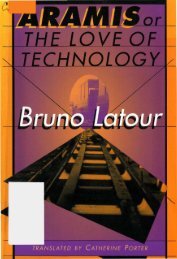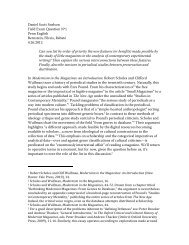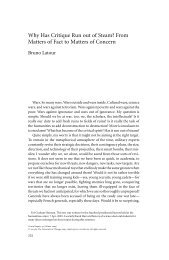The Exploit: A Theory of Networks - asounder
The Exploit: A Theory of Networks - asounder
The Exploit: A Theory of Networks - asounder
You also want an ePaper? Increase the reach of your titles
YUMPU automatically turns print PDFs into web optimized ePapers that Google loves.
Edges 141<br />
If Latour gives us a paradoxically anthropomorphic version <strong>of</strong> the<br />
nonhuman, then Jean - François Lyotard gives us the opposite: the abso -<br />
lute limit <strong>of</strong> the human, a quantum, even cosmic, nonhuman. Lyo -<br />
tard prefers the term “inhuman,” but we detect the same debate in<br />
his later writings. Lyotard suggests that one does not need to theorize<br />
the nonhuman, for a process <strong>of</strong> “dehumanization” has already been<br />
taking place for some time via postmodern technology and postindustrial<br />
capitalism. An inhumanity is produced in which all politics<br />
is reduced to voting, all culture to fashion, all subjectivity to the<br />
stratifications <strong>of</strong> class, and so on. <strong>The</strong> only response, he argues, is to<br />
discover another kind <strong>of</strong> inhuman, one that is a “no - man’s land,”<br />
one that explores another type <strong>of</strong> transformation, a transformative<br />
transformation (rather than a change that produces the same).<br />
“Humanity is only human if people have this ‘no - man’s land.’” 46 By<br />
definition, this potential site <strong>of</strong> resistance cannot be named unless<br />
it is discovered. For Lyotard, this is the domain <strong>of</strong> our contemporary<br />
“sublime” in the arts, the very site <strong>of</strong> discovering that which is<br />
beyond representation, that which lies beyond human thought<br />
itself.<br />
Between these two approaches to the nonhuman, an incorporating<br />
and a discorporating one, the nonhuman continues to be negatively<br />
defined: the human “minus” something, or “what the human is<br />
not.” One always begins from the human and then moves outward.<br />
But what <strong>of</strong> a nonhuman within the human, just as the swarm may<br />
emanate from within the network? Or better, what <strong>of</strong> a nonhuman<br />
that traverses the human, that runs through the human? Would this<br />
not be the “matter” <strong>of</strong> the nonhuman? By contrast, the matter <strong>of</strong> the<br />
human is hylomorphic, a set <strong>of</strong> matters that have their end in a given<br />
form, matter - into - form, form as the telos <strong>of</strong> matter. This is the human<br />
view <strong>of</strong> technology, instrumentality as the ability literally to shape<br />
the world. <strong>The</strong> inverse <strong>of</strong> this would be a metallomorphic model, <strong>of</strong><br />
which metallurgy is the privileged example. “Matter and form have<br />
never seemed more rigid than in metallurgy; yet the succession <strong>of</strong> forms<br />
tends to be replaced by the form <strong>of</strong> a continuous development, and the<br />
variability <strong>of</strong> matters tends to be replaced by the matter <strong>of</strong> a continuous<br />
variation.” 47 Melting, forging, quenching, molding—metallurgy









